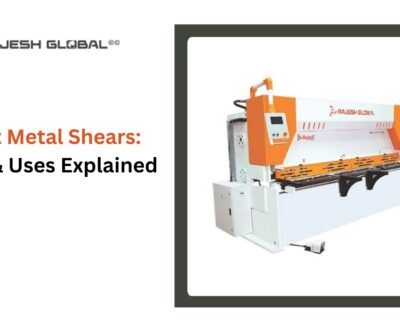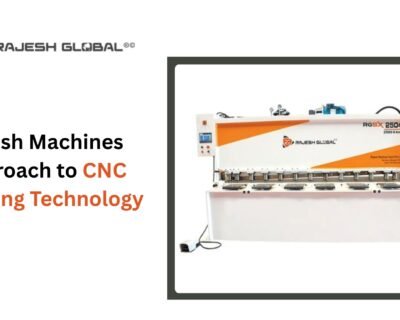Blog

Shearing Machines Explained: Types and Applications
The metalworking industry stands at a fascinating crossroads where ancient craftsmanship meets cutting-edge precision engineering. At the heart of this transformation lies a deceptively simple yet revolutionary tool: the shearing machine. While most entrepreneurs focus on flashy automation and AI-driven solutions, savvy manufacturers understand that mastering the fundamentals of metal shearing can unlock production capabilities that separate industry leaders from followers.
The same fundamental principle that ancient Romans used to cut thin metal sheets now powers multi-million-dollar production lines capable of processing over 2 tons of material per hour. The evolution from manual scissors to hydraulic powerhouses represents more than technological advancement — it’s a masterclass in how understanding core processes can drive exponential business growth.
For startup entrepreneurs entering the manufacturing space, shearing machines represent a critical decision point that can make or break operational efficiency. The difference between choosing the right shearing solution and settling for an inadequate one often determines whether a business scales smoothly or struggles with production bottlenecks that hemorrhage both time and capital.
What is a Shearing Machine?
Contents
- 1 What is a Shearing Machine?
- 2 Evolution of Shearing Machines
- 3 Major Types of Shearing Machines
- 4 Mechanical vs. Hydraulic vs. CNC
- 5 Applications Across Industries
- 6 Rajesh CNC’s Contribution
- 7 How Shearing Machines Fit into an Integrated Fabrication Line
- 8 Key Considerations for Shearing Machine Selection
- 9 Shearing Machine Myths
- 10 Shearing’s Smart Horizon
- 11 Bottom Note
A shearing machine fundamentally operates by applying shear stress through a die and punch system, remarkably similar to punching paper but with forces measured in tons rather than ounces. The elegance lies in its simplicity: two blades working in precise coordination to cut through metal without generating heat or creating chips—a process that preserves material integrity while achieving clean, precise cuts.
The mechanics involve “a die and punch [that] can have different shapes, such as circular or straight blades that resemble scissors”. What makes this process particularly valuable for entrepreneurs is its versatility—shearing operations can split metals into sheets or strips with minimal waste, a crucial factor when material costs directly impact profit margins. The type of blade configuration, whether straight or rotatory, determines the specific cutting capabilities and influences everything from production speed to final product quality.
Evolution of Shearing Machines
The journey from Bronze Age scissors to today’s precision machinery reads like a technological thriller. “The earliest form of metal shearing dates back to the Bronze Age with the use of manually operated scissors”2, initially designed for softer materials but later adapted for thin metal sheets. Ancient metalworkers discovered they could cut and shape gold and copper plates using harder implements, laying the groundwork for modern manufacturing processes.
The Roman Empire brought the first major breakthrough with “spring-loaded blades [that] evolved into hinged scissors”2, marking the transition from purely manual labor to mechanical advantage. But the real game-changer arrived in the 16th century with the rolling mill revolution. This device, “inspired by the baker’s rolling pin, used two heavy cylinders rotating in tandem to produce uniformly thin metal sheets”2, creating the demand for more sophisticated cutting solutions.
The industrial revolution accelerated innovation, leading to “lever-type shears, which evolved into alligator shears and bench shears. Each advancement solved specific production challenges while opening new possibilities for manufacturers willing to invest in better equipment.
Major Types of Shearing Machines
Alligator Shears: The Heavy-Duty Workhorses
Alligator shears dominate when raw cutting power matters most. These machines feature a hinged jaw, powered by a flywheel or hydraulic cylinder, with jaw sizes ranging from 4 to 36 in (100 to 910 mm) long. They excel at cutting ferrous materials like rebar, pipe, and I-beams—perfect for construction-focused entrepreneurs.
Bench Shears: Precision in Compact Form
For medium-sized operations, bench shears offer “a compound mechanism to increase the mechanical advantage” while maintaining bench-mounted convenience. These units handle rough shaping of medium-sized sheet metal pieces, though they can’t manage delicate work requiring fine tolerances.
Guillotine Shears: The Production Powerhouses
The most sophisticated category, guillotine shears (also called squaring shears or power shears) represent the pinnacle of cutting precision. They work by “first clamping the material with a ram [while] a moving blade then comes down across a fixed blade to shear the material. The secret sauce lies in the shear angle—a 5-degree shear angle decreases the force by about 20%, allowing efficient processing of thicker materials.
Rotary Shears: Continuous Production Champions
In metallurgical plants, rotary shears serve as “crucial metal processing machines used in continuous or semi-continuous production lines. Their primary function involves cutting irregular edges from strip steel, ensuring products meet precise dimensional requirements—a capability that’s invaluable for manufacturers serving automotive or aerospace markets.
Mechanical vs. Hydraulic vs. CNC
The power source decision represents a critical inflection point for any manufacturing business:
Mechanical Systems rely on flywheels and gear reduction, offering consistent performance and lower maintenance costs. They excel in high-volume, repetitive operations where speed matters more than ultimate precision.
Hydraulic Systems deliver superior force control and can handle thicker materials with ease. Modern hydraulic shears like the AS-200 model generate 200 tons of shear force while maintaining 7-8 strokes per minute — perfect for heavy-duty applications.
CNC Integration transforms shearing from a manual craft into a precision science. Computer control enables repeatable positioning, automated material handling, and integration with broader manufacturing systems, though at significantly higher initial investment.
Applications Across Industries
Manufacturing versatility makes shearing machines indispensable across diverse sectors. In construction, they process structural steel and rebar with precision that manual cutting simply cannot match. Automotive manufacturers rely on shearing for body panels and chassis components where dimensional accuracy directly impacts safety and performance.
The aerospace industry demands the ultimate in precision—here, shearing machines must deliver tolerances measured in thousandths of inches while maintaining edge quality that prevents stress concentrations. Electronics manufacturers use smaller shearing systems for circuit board fabrication and component housing production.
Perhaps most importantly for entrepreneurs, the scrap metal industry depends entirely on efficient shearing. Modern alligator shears can process up to 2 tons/hr of mixed materials, transforming waste streams into valuable commodities with remarkable efficiency.
Rajesh CNC’s Contribution
Rajesh Machine Tools Pvt. Ltd. exemplifies how focused specialization can build industry leadership. As manufacturers engaged in the manufacturing of sheet metal & all types of fabrication machines, especially Press Brakes and Shearing Machines, they’ve carved out a dominant position by understanding that excellence in fundamentals beats diversification across mediocre products.
Their approach demonstrates a crucial lesson for entrepreneurs: rather than chasing every market opportunity, building deep expertise in core technologies often yields superior returns and customer loyalty.
How Shearing Machines Fit into an Integrated Fabrication Line
Modern manufacturing success depends on seamless integration rather than isolated excellence. Before you start integrating shearing machines, it’s essential to perform a thorough evaluation of your existing sheet metal equipment. The key lies in understanding communication protocols, data exchange capabilities, and workflow optimization.
Smart integration enables automated material handling, real-time quality monitoring, and predictive maintenance scheduling. When properly configured, integrated shearing systems can eliminate bottlenecks that traditionally limited production capacity, while providing data insights that drive continuous improvement.
Key Considerations for Shearing Machine Selection
- Material Specifications: Understanding your material thickness range, tensile strength, and edge quality requirements determines baseline capabilities.
- Production Volume: Daily throughput requirements influence whether mechanical, hydraulic, or CNC systems provide optimal cost-effectiveness.
- Integration Requirements: Future expansion plans should guide communication protocol and automation compatibility decisions.
- Maintenance Philosophy: Some operations prioritize maximum uptime through robust mechanical systems, while others prefer predictive maintenance enabled by smart sensors and data analytics.
Shearing Machine Myths
Myth: Bigger always means better performance.
Reality: Oversized equipment often reduces efficiency and increases operating costs without improving output quality.
Myth: Manual operation provides better control than automation.
Reality: Modern CNC systems deliver consistency that human operators cannot match while reducing fatigue-related errors.
Myth: Hydraulic systems are inherently unreliable.
Reality: Properly maintained hydraulic shears often exceed mechanical system longevity while providing superior force control.
Shearing’s Smart Horizon
The future belongs to manufacturers who embrace intelligent manufacturing. IoT-enabled shearing machines now provide real-time performance data, predictive maintenance alerts, and integration with enterprise resource planning systems. Artificial intelligence algorithms optimize cutting parameters based on material properties and desired outcomes, while machine learning continuously improves performance through operational feedback.
Advanced materials like carbon fiber composites and exotic alloys demand increasingly sophisticated shearing capabilities. The manufacturers who invest in understanding these evolving requirements today will dominate tomorrow’s markets.
Bottom Note
Shearing machines represent far more than simple cutting tools—they embody the fundamental principle that mastering basic processes enables extraordinary results. For entrepreneurs entering manufacturing, the choice isn’t whether to invest in quality shearing equipment, but rather which configuration best positions your operation for sustained growth and competitive advantage.
The companies that thrive understand this truth: exceptional manufacturing begins with exceptional fundamentals. Shearing machines provide the foundation upon which manufacturing excellence is built, one precise cut at a time.







